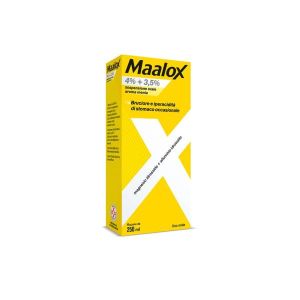Ship in Europe, Find out rates!
Language

Maalox Oral Suspension Mint Flavor 4%+3.5% Antacid 250ml
SANOFI
SKU
020702282
Special Price
€12.35
Regular Price
€13.90
Save... €1.55
-11%
Recent lowest price:
€12.29
In stock
NAME
MAALOX 4% + 3.5% ORAL SUSPENSION MINT FLAVOR
PHARMACOTHERAPEUTIC CATEGORY
Antacids.
ACTIVE PRINCIPLES
100 ml of suspension contain: magnesium hydroxide; aluminum hydroxide; equivalent to aluminum oxide.
EXCIPIENTS
Hydrochloric acid (10%), citric acid (monohydrate), mint essence, mannitol (E421), domifene bromide, sodium saccharin, 70% non-crystallizable liquid sorbitol (E420), hydrogen peroxide solution 30% and purified water.
INDICATIONS
Symptomatic treatment of occasional heartburn and hyperacidity of the stomach.
CONTRAINDICATIONS / SECONDARY EFFECT
Hypersensitivity 'to the active ingredients or to any of the listed excipients; patients with porphyria; severe forms of renal insufficiency; contraindicated in pediatric age; state of cachexia.
DOSAGE
Swallow 2 to 4 teaspoons of oral suspension 4 times a day, 20-60 minutes after meals and at bedtime. Do not exceed the maximum indicated dose of 16 tsp. Pediatric population: the product is contraindicated in children and adolescents under 18 years of age. Method of administration: for oral use. Shake well before use.
STORAGE
Store below 25 degrees C.
WARNINGS
Aluminum hydroxide can cause constipation and an overdose of magnesium salts can cause hypomotility of the intestine; high doses of this medicine can cause or aggravate intestinal obstruction and ileus in patients at higher risk, such as those with renal impairment, with basic constipation, with impaired intestinal motility, in children (0 to 24 months ), or the elderly. Aluminum hydroxide is not well absorbed from the gastrointestinal tract, and systemic effects are therefore rare in patients with normal renal function. However, excessive doses or long-term use, or even normal doses in patients with low phosphorus diets or children (0 to 24 months), can lead to phosphate elimination (due to an aluminum-phosphate bond) accompanied by an increase in bone resorption and hypercalciuria with risk of osteomalacia. It is advisable to monitor patients for long-term use or patients at risk of hypophosphataemia. In patients with renal impairment, plasma levels of aluminum and magnesium tend to increase causing hyperalluminaemia and hypermagnesaemia, respectively. In these patients, long exposures to high doses of aluminum and magnesium salts can lead to encephalopathies, dementia, microcytic anemia or worsening of osteomalacia due to dialysis. In the presence of mild and moderate forms of renal impairment, the medicinal product should be taken under medical supervision and prolonged use of the medicinal product should be avoided. The administration of this medicine in subjects suffering from severe forms of renal insufficiency and 'contraindicated. Aluminum hydroxide may be unsafe in patients with porphyria undergoing hemodialysis. The drug is contraindicated in patients with porphyria. This medicine contains sorbitol. This medicinal product contains less than 1 mmol (23 mg) sodium per dose, ie 'essentially' sodium-free '.
INTERACTIONS
Since 'Al and Mg salts reduce the gastrointestinal absorption of etetracyclines, it is recommended to avoid taking the drug during oral tetracycline therapy. The use of aluminum-containing antacids can reduce the absorption of drugs such as H 2-antagonists, atenolol, cefdinir, cefpodoxime, chloroquine, tetracyclines, diflunisal, digoxin, bisphosphonates, ethambutol, fluoroquinolones, sodium fluoride, glucocorticoids, indomethacin, isoniazid, ketoconazole, levothyroxine, lincosamides, metoprolol, phenothiazine neuroleptics, penicillamines, propranolol, rosuvastatin, iron salts. Caution is recommended when the medicine is taken together with polystyrene sulphonate (Kayexalate) due to the potential risk of the resin's reduced efficacy in binding potassium, of metabolic alkalosis in patients with renal impairment (reported with aluminum hydroxide and magnesium hydroxide) and of intestinal obstruction (reported with aluminum hydroxide). Aluminum hydroxide and citrates can cause hyperalluminaemia, especially in patients with renal impairment. Allow at least two hours (4 for fluoroquinolones) before taking the drug to avoid interaction with other drugs. Simultaneous use of quinidine may result in increased serum quinidine levels and lead to quinidine overdose. The simultaneous use of aluminum hydroxide and citrates can lead to an increase in aluminum levels, particularly in patients with renal insufficiency.
SIDE EFFECTS
The frequency of the undesirable effects reported below is defined using the following conventions: common (> = 1/100, <1/10); uncommon (> = 1 / 1,000, <1/100); rare (> = 1 / 10,000, <1 / 1,000); very rare (<1 / 10,000); not known Immune system disorders. Frequency not known: angioedema, anaphylactic reactions, hypersensitivity reactions, urticaria, pruritus. Gastrointestinal disorders. Uncommon: diarrhea or constipation. Metabolism and nutrition disorders. Frequency not known: hypermagnesaemia, hyperalluminaemia, hypophosphataemia, during prolonged use or at high doses or even at normal doses of the drug in patients with low phosphorus diets or in children (0 to 24 months), which can cause an increase in bone resorption, hypercalciuria, osteomalacia. The reporting of suspected adverse reactions that occur after the authorization of the drug is important, as it allows continuous monitoring of the benefit / risk ratio of the drug.
PREGNANCY AND BREASTFEEDING
The medicine should be used only in case of need ', after evaluating the expected benefit to the mother in relation to the possible risk to the fetus or infant. Due to limited maternal absorption when taken according to the indicated dosage regimen, aluminum hydroxide and its combinations with magnesium salts are considered compatible with breastfeeding.
MAALOX 4% + 3.5% ORAL SUSPENSION MINT FLAVOR
PHARMACOTHERAPEUTIC CATEGORY
Antacids.
ACTIVE PRINCIPLES
100 ml of suspension contain: magnesium hydroxide; aluminum hydroxide; equivalent to aluminum oxide.
EXCIPIENTS
Hydrochloric acid (10%), citric acid (monohydrate), mint essence, mannitol (E421), domifene bromide, sodium saccharin, 70% non-crystallizable liquid sorbitol (E420), hydrogen peroxide solution 30% and purified water.
INDICATIONS
Symptomatic treatment of occasional heartburn and hyperacidity of the stomach.
CONTRAINDICATIONS / SECONDARY EFFECT
Hypersensitivity 'to the active ingredients or to any of the listed excipients; patients with porphyria; severe forms of renal insufficiency; contraindicated in pediatric age; state of cachexia.
DOSAGE
Swallow 2 to 4 teaspoons of oral suspension 4 times a day, 20-60 minutes after meals and at bedtime. Do not exceed the maximum indicated dose of 16 tsp. Pediatric population: the product is contraindicated in children and adolescents under 18 years of age. Method of administration: for oral use. Shake well before use.
STORAGE
Store below 25 degrees C.
WARNINGS
Aluminum hydroxide can cause constipation and an overdose of magnesium salts can cause hypomotility of the intestine; high doses of this medicine can cause or aggravate intestinal obstruction and ileus in patients at higher risk, such as those with renal impairment, with basic constipation, with impaired intestinal motility, in children (0 to 24 months ), or the elderly. Aluminum hydroxide is not well absorbed from the gastrointestinal tract, and systemic effects are therefore rare in patients with normal renal function. However, excessive doses or long-term use, or even normal doses in patients with low phosphorus diets or children (0 to 24 months), can lead to phosphate elimination (due to an aluminum-phosphate bond) accompanied by an increase in bone resorption and hypercalciuria with risk of osteomalacia. It is advisable to monitor patients for long-term use or patients at risk of hypophosphataemia. In patients with renal impairment, plasma levels of aluminum and magnesium tend to increase causing hyperalluminaemia and hypermagnesaemia, respectively. In these patients, long exposures to high doses of aluminum and magnesium salts can lead to encephalopathies, dementia, microcytic anemia or worsening of osteomalacia due to dialysis. In the presence of mild and moderate forms of renal impairment, the medicinal product should be taken under medical supervision and prolonged use of the medicinal product should be avoided. The administration of this medicine in subjects suffering from severe forms of renal insufficiency and 'contraindicated. Aluminum hydroxide may be unsafe in patients with porphyria undergoing hemodialysis. The drug is contraindicated in patients with porphyria. This medicine contains sorbitol. This medicinal product contains less than 1 mmol (23 mg) sodium per dose, ie 'essentially' sodium-free '.
INTERACTIONS
Since 'Al and Mg salts reduce the gastrointestinal absorption of etetracyclines, it is recommended to avoid taking the drug during oral tetracycline therapy. The use of aluminum-containing antacids can reduce the absorption of drugs such as H 2-antagonists, atenolol, cefdinir, cefpodoxime, chloroquine, tetracyclines, diflunisal, digoxin, bisphosphonates, ethambutol, fluoroquinolones, sodium fluoride, glucocorticoids, indomethacin, isoniazid, ketoconazole, levothyroxine, lincosamides, metoprolol, phenothiazine neuroleptics, penicillamines, propranolol, rosuvastatin, iron salts. Caution is recommended when the medicine is taken together with polystyrene sulphonate (Kayexalate) due to the potential risk of the resin's reduced efficacy in binding potassium, of metabolic alkalosis in patients with renal impairment (reported with aluminum hydroxide and magnesium hydroxide) and of intestinal obstruction (reported with aluminum hydroxide). Aluminum hydroxide and citrates can cause hyperalluminaemia, especially in patients with renal impairment. Allow at least two hours (4 for fluoroquinolones) before taking the drug to avoid interaction with other drugs. Simultaneous use of quinidine may result in increased serum quinidine levels and lead to quinidine overdose. The simultaneous use of aluminum hydroxide and citrates can lead to an increase in aluminum levels, particularly in patients with renal insufficiency.
SIDE EFFECTS
The frequency of the undesirable effects reported below is defined using the following conventions: common (> = 1/100, <1/10); uncommon (> = 1 / 1,000, <1/100); rare (> = 1 / 10,000, <1 / 1,000); very rare (<1 / 10,000); not known Immune system disorders. Frequency not known: angioedema, anaphylactic reactions, hypersensitivity reactions, urticaria, pruritus. Gastrointestinal disorders. Uncommon: diarrhea or constipation. Metabolism and nutrition disorders. Frequency not known: hypermagnesaemia, hyperalluminaemia, hypophosphataemia, during prolonged use or at high doses or even at normal doses of the drug in patients with low phosphorus diets or in children (0 to 24 months), which can cause an increase in bone resorption, hypercalciuria, osteomalacia. The reporting of suspected adverse reactions that occur after the authorization of the drug is important, as it allows continuous monitoring of the benefit / risk ratio of the drug.
PREGNANCY AND BREASTFEEDING
The medicine should be used only in case of need ', after evaluating the expected benefit to the mother in relation to the possible risk to the fetus or infant. Due to limited maternal absorption when taken according to the indicated dosage regimen, aluminum hydroxide and its combinations with magnesium salts are considered compatible with breastfeeding.
| Destination | Cost | Detail |
|---|---|---|
| Italy | €5,90* | 24/72H |
| Austria, France, Germany, Slovenia | € 13* | 3 days |
| Belgium, Luxembourg, Portugal, Netherlands, Spain | € 14* | 4 days |
| Bulgary, Cechia, Hungary, Poland, Romania, Slovakia | € 19* | 5 days |
| Denmark, Estonia, Finland, Ireland, Lithuania, Latvia ,Sweden | € 22* | 5 days |
| United Kingdom, Switzerland, Greece | € 30* | 7 days |
| Canada, USA | € 40 | 7 Days |
European shipments with express courier: FedEx, MBE, DHL
*For the shipment outside band B ther's an extra cost of 22€ *For the shipment outside band C ther's an extra cost of 30€ Delivery Times exclude Saturday and Holidays
For Islands and Areas of difficult Accessibility the shipments are made in 72 hours and the cost will be increased by 15€
The images of the products shown on our site are purely indicative and may differ in shape, color, text and packaging shown on them. Given the difficulty of updating all the products on our site in real time or any errors, XFarma.it, all products will be identified through SKU MINSAN (code of the Ministry of Health).
The transport of medicines sold online is carried out in compliance with the guidelines on good distribution practice according to Article 112-quater, paragraph 10. (Italy)
